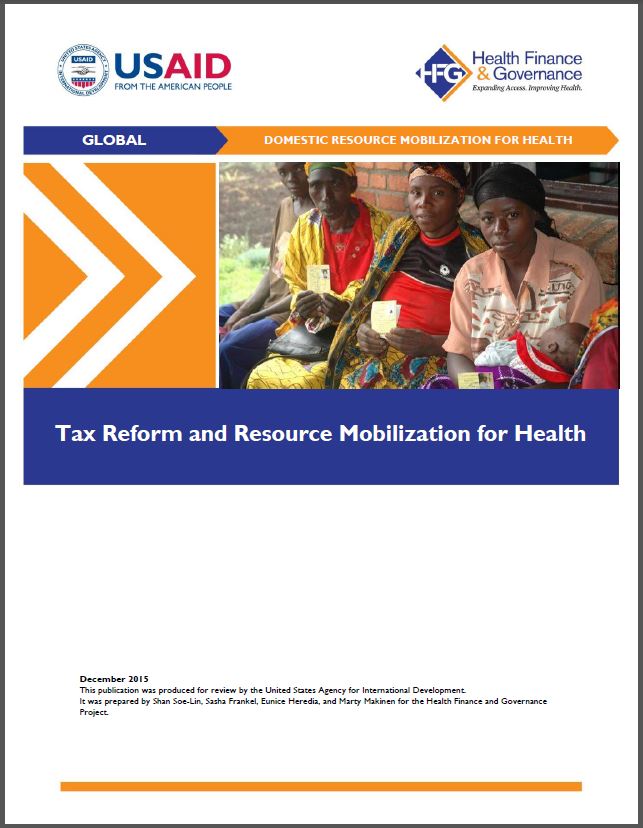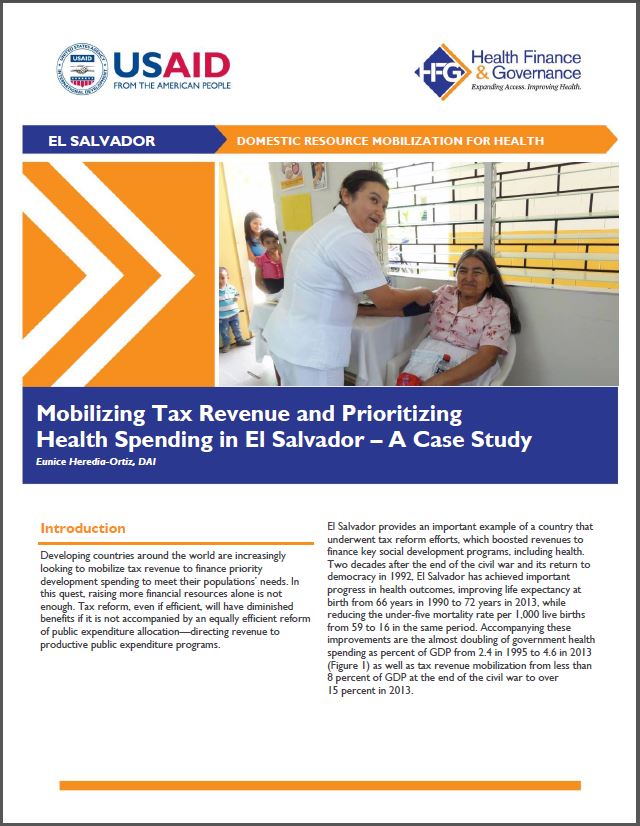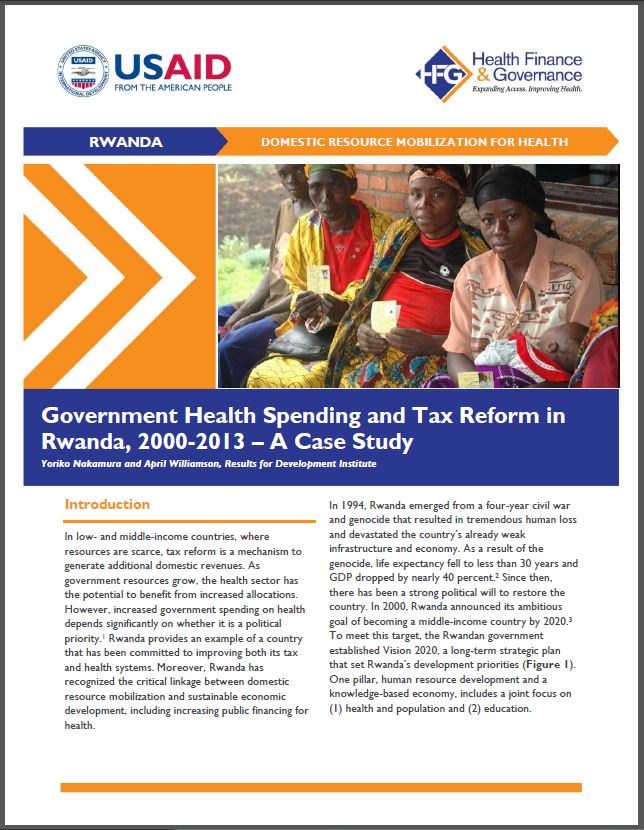Tax Reform as a Strategy to Mobilize Additional Resources for Health
Announcements, Health Finance, Publications, Resource Mobilization, Where We Work
 As development assistance for health shrinks and the demand for health expenditures increases, developing countries are under mounting pressure to provide adequate resources for health. Governments can increase available public resources by benefiting from overall economic growth, borrowing, making efficiency gains, and reforming tax laws and improving tax administration, among others. Tax Reform and Resource Mobilization for Health examines whether improvements in tax revenue performance due to tax administration reform result in increases in available government funds that benefit the health sector and the conditions that facilitate greater allocations toward health spending.
As development assistance for health shrinks and the demand for health expenditures increases, developing countries are under mounting pressure to provide adequate resources for health. Governments can increase available public resources by benefiting from overall economic growth, borrowing, making efficiency gains, and reforming tax laws and improving tax administration, among others. Tax Reform and Resource Mobilization for Health examines whether improvements in tax revenue performance due to tax administration reform result in increases in available government funds that benefit the health sector and the conditions that facilitate greater allocations toward health spending.
Many countries are still far from reaching their tax capacity. If countries’ tax effort rose to the average rate, then government health expenditures could also increase by meaningful amounts. In an example from the Philippines, this amounted to an increase by an additional $2-$8 per capita in government health expenditures. Our analysis of empirical data from 188 countries over 18 years (1995 – 2012) found that increased tax revenues do not necessarily translate to increased health spending.
Based on the country experiences of Ethiopia and Lesotho, where increases in tax-derived revenue were associated with increased allocation to the health sector, this study identifies four factors that favor the allocation of additional tax revenue toward the health sector: generating national political priority for health, creating tax funds specifically for health, earmarking a proportion of tax revenue mobilized, and decentralizing spending.
This report is complemented by two in-depth country case studies, El Salvador and Rwanda. Both of these countries implemented successful tax administration reforms that, together with other measures, significantly increased government allocations to health.
 Mobilizing Tax Revenue and Prioritizing Health Spending in El Salvador – A Case Study
Mobilizing Tax Revenue and Prioritizing Health Spending in El Salvador – A Case Study
El Salvador provides an important example of a country that underwent tax reform efforts, which boosted revenues to finance key social development programs, including health. Two decades after the end of the civil war and its return to democracy in 1992, El Salvador has achieved important progress in health outcomes, improving life expectancy at birth from 66 years in 1990 to 72 years in 2013, while reducing the under-five mortality rate per 1,000 live births from 59 to 16 in the same period. Accompanying these improvements are the almost doubling of government health spending as percent of GDP from 2.4 in 1995 to 4.6 in 2013 as well as tax revenue mobilization from less than 8 percent of GDP at the end of the civil war to over 15 percent in 2013.
Allocating 18 percent of general government expenditure to the health sector, the Government of El Salvador (GOES) greatly surpasses the average for Latin American countries, which was 10 percent in 2013, and reaches the average for OECD countries. This case study provides a review and analysis of tax policy and administration reforms introduced in El Salvador in the past two decades, the resulting tax revenue mobilization, and the impact on government health spending.
 Government Health Spending and Tax Reform in Rwanda, 2000-2013 – A Case Study
Government Health Spending and Tax Reform in Rwanda, 2000-2013 – A Case Study
Rwanda provides an example of a country that has been committed to improving both its tax and health systems. Moreover, Rwanda has recognized the critical linkage between domestic resource mobilization and sustainable economic development, including increasing public financing for health.
In 1994, Rwanda emerged from a four-year civil war and genocide that resulted in tremendous human loss and devastated the country’s already weak infrastructure and economy. As a result of the genocide, life expectancy fell to less than 30 years and GDP dropped by nearly 40 percent. Since then, there has been a strong political will to restore the country. In 2000, Rwanda announced its ambitious goal of becoming a middle-income country by 2020. To meet this target, the Rwandan government established Vision 2020, a long-term strategic plan that set Rwanda’s development priorities. As Rwanda has strived to meet the goals of Vision 2020, it has increased its development-related investments. This has required Rwanda to mobilize greater domestic resources, particularly as it aims to reduce its dependency on foreign aid. As a result of a series of reforms, tax revenue as a percent of GDP rose from 3.6% in 1994 to 13.4% in 2013.
Improvements in tax generation have benefited the health sector. Rwanda has focused on investments in human resource development, as it has recognized the socioeconomic value of building a healthy and educated population. In the early 2000s, Rwanda “reoriented” its government expenditures toward basic health and education. This case study looks at the tax reforms Rwanda has introduced over the past two decades to increase domestic revenue collection, the subsequent improvements in revenue generation, and the impact these changes have had on the health sector.



